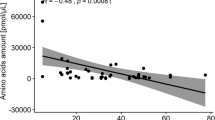Summary
The floral nectar of angiosperms is primarily a solution of simple sugars, but contains detectable amounts of other solutes, particularly amino acids. These have been regarded as diagnostic, for phylogenetic and taxonomic purposes, and their mean concentrations may be significant in relation to the pollination syndrome of a plant species. However, in several temperate flowers the amino acid concentration varied by an order of magnitude when measured at intervals through a single day. In open, cup-shaped flowers, this was partly due to post-secretory equilibration with the varying humidity of the air. But the effects of floral visitation by insects on nectar amino acids were also important, both in open flowers and in those with long corollas and more enclosed nectar. Visitors could add amino acids to nectar by direct contact, by salivation, by damaging the neighbouring tissues causing cell leakage, and by dislodging pollen into the nectar; the importance of each of these effects varied according to corolla morphology and the spectrum of visitors.
Similar content being viewed by others
References
Baker HG (1978) Chemical aspects of the pollination biology of woody plants in the tropics. In: PB Tomlinson & MH Zimmerman (ed) ‘Tropical Trees as living systems’. University Press, Cambridge, pp 57–82
Baker HG, Baker I (1973a). Amino acids in nectar and their evolutionary significance. Nature Lond 241:543–545
Baker HG, Baker I (1973b). Some anthecological aspects of the evolution of nectar producing flowers, particularly amino acid production in nectar. In: VH Heywood (ed), ‘Taxonomy and Ecology’ Academic Press, New York p 243–264
Baker HG, Baker I (1975). Studies of nectar constitution and pollinatorplant coevolution. In: ‘Coevolution of animals and plants’ LE Gilbert and PH Raven (ed). Univ. of Texas Press, Austin and London, p 100–140
Baker HG, Baker I (1977) Intraspecific constancy of floral nectar amino acid complements. Bot Gaz 138:183–191
Baker I, Baker HG (1976) Analyses of amino acids in flower nectars of hybrids and their parents, with phylogenetic implications. New Phytol 76:87–98
Beutler R (1953) Nectar. Bee World 34:106–116, 128–136, 156–162
Boetius J (1948) Über den Verlauf der Nektarabsonderung einiger Blütenpflanzen. Beih Sweiz Bienenzeitung 2:257–317
Bünning E (1959) Die seismonastischen Reaktionen. In: W Ruhland (ed) Handbuch der Pflanzenphysiologie. Vol 17 1 Springer, Berlin Heidelberg New York, p 184–238
Corbet SA, Unwin DM, Prŷs-Jones OE (1979) Humidity, nectar and insect visits to flowers with special reference to Crataegus, Tilia and Echium. Ecol Ent 4:9–22
Corbert SA, Willmer PG Regulating nectar sugar concentrations in a humid climate. In prep
Corbet SA, Willmer PG, Beament JWL, Unwin DM, Prŷs-Jones OE (1979) Post-secretory determinants of sugar concentration in nectar. Plant Cell and Environment 2:293–308
Faegri K, van der Pijl L (1979). The principles of Pollination Ecology. 3rd ed Pergamon Press, Oxford
Free JB (1968) The behaviour of bees visiting runner beans (Phaseolus multiflorus). J Appl Ecol 5:631–638
Gilbert LE (1972) Pollen feeding and reproductive biology of Heliconius butterflies. Proc Nat Acad Sci USA 69:1403–1407
Heinrich B, Raven PH (1972) Energetics and pollination ecology. Science 176:597–602
Huber H (1956) Die Abhängigkeit der Nektarsekretion von Temperatur, Luft- und Bodenfeuchtigkeit. Planta 48:47–98
Kenoyer LA (1917) Environmental influences on nectar secretion. Bot Gaz 63:249–265
Kumazawa M (1936) Pollen grain morphology in Ranunculaceae, Lardizabalaceae and Berberidaceae. Jap J Bot 8:19–46
Linskens HF, Schrauwen J (1969) The release of free amino acids from germinating pollen. Acta Bot Neerl 18:605–614
Lüttge H (1977) Nectar composition and membrane transport of sugars and amino acids: a review on the present state of nectar research. Apidologie 8:305–319
Macior L (1966) Foraging behaviour of Bombus (Hymenoptera: Apidae) in relation to Aquilegia pollination. Am J Bot 53:302–309
Maier CT, Waldbauer GP (1979) Diurnal activity patterns of flower flies (Diptera: Syrphidae) in an Illinois sand area. Ann Ent Soc Am 72:237–245
Oertel E (1946) Effect of temperature and relative humidity on sugar concentration of nectar. J Econ Ent 39:513–515
Park OW (1929) The influence of humidity upon sugar concentration in the nectar of various plants. J Econ Ent 22:534–544
Percival MS (1965) Floral Biology. Pergamon Press, Oxford
Pesti J (1976) Daily fluctuations in the sugar content of nectar and periodicity of secretion in the Compositae. Acta Agro Acad Sci Hung 25:5–17
Proctor M, Yeo PF (1973) The Pollination of Flowers. Collins, New Naturalist
Sibaoka T (1969) Physiology of rapid movements in higher plants. Ann Rev Plant Physiol 20:165–184
Stanley RG, Linskens HF (1975) Pollen: Biology, Biochemistry. Management. Springer, Berlin Heidelberg New York
Unwin DM (1979) In: Corbet, Unwin und Prŷs-Jones Ecol Ent 4:9–22
Willmer PG, Corbet SA Temporal and microclimatic partitioning of the floral resources of Justicia aurea amongst a concourse of pollen vectors and nectar thieves. Submitted to Ecology
Author information
Authors and Affiliations
Rights and permissions
About this article
Cite this article
Willmer, P.G. The effects of insect visitors on nectar constituents in temperate plants. Oecologia 47, 270–277 (1980). https://doi.org/10.1007/BF00346832
Received:
Issue Date:
DOI: https://doi.org/10.1007/BF00346832




